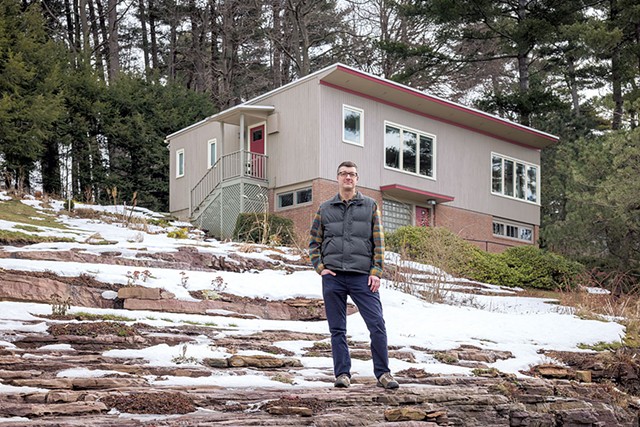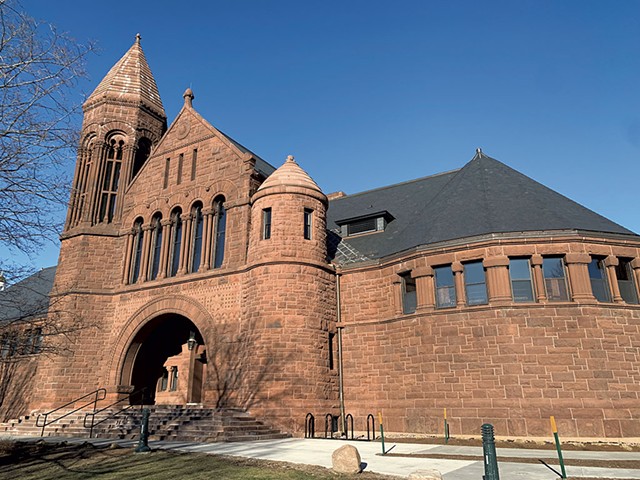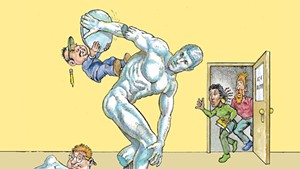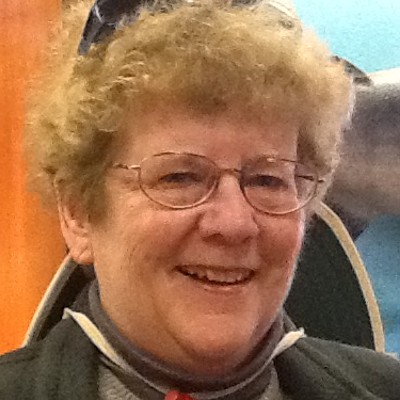
- Oliver Parini
- Devin Colman in front of his favorite midcentury house in Burlington
On January 24, the preservation experts of seven northeastern states, including Pennsylvania and New York, convened for a webinar on historic barns, hosted by the New Hampshire Preservation Alliance. One of the three invited guest speakers was Tom Visser, professor and director of the master's of science program in historic preservation at the University of Vermont.
In the subsequent breakout session for Vermont, the main speakers, Vermont state architectural historian Devin Colman and Preservation Trust of Vermont field service representative Alex Tolstoi, greeted each other familiarly. Both graduates of Visser's program, they gave a shout-out to a third grad, Caitlin Corkins, tax credits and grants coordinator at the Vermont Division for Historic Preservation, who didn't make it to the event.
What these professionals didn't mention was that their common graduate program was on the chopping block. On December 2, Bill Falls, dean of UVM's College of Arts and Sciences, proposed phasing out 12 majors, 11 minors and four master's programs. Aimed at culling low-enrollment programs, the cost-cutting measure is designed to combat the university's $8.6 million deficit for fiscal year 2021. (Learn more about it in Seven Days' January 27 cover story, "Major Fallout.")
The historic preservation program was a conspicuous target for Falls' plan. Small and personalized by design, it typically graduates five to 15 students a year — more when the economy is down, fewer when it's up — and employs just two full-time professors: Visser and Robert McCullough.
The fate of the master's degree in historic preservation isn't yet sealed. But graduates worry about what Vermont might lose with it, because this small operation has had an outsize impact.
Since the program launched in 1975, its 375-plus graduates have populated every level and sector of preservation jobs in the state. A graduate of its inaugural class, John Dumville oversaw Vermont's state-owned historic sites — such as the Bennington Monument — for 35 years until he retired in 2014. Both of his successors, Tracy Martin and Jamie Duggan, are graduates of the UVM program.
Graduates have gone into the profession of municipal planning and regulatory review, such as Sarah Hadd, director of planning and zoning for the Town of Colchester, and Mary O'Neil, principal planner for the City of Burlington. The nonprofit Preservation Trust of Vermont currently employs four graduates of the UVM program: easement program director Meg Campbell and field-service reps Tolstoi, Lisa Ryan and Jenna Lapachinski. Other grads have entered the private sector, including Eliot Lothrop, who started the Huntington-based restoration firm Building Heritage.
Alumni of the UVM program have distinguished themselves elsewhere, too. Mark Wolfe, a 1990 graduate, holds the top preservation job in Texas — executive director of the state historic preservation office. Daniel Leckie, class of 2014, is an associate architectural historian at the California Department of Transportation, Central Region. According to McCullough, graduates have found jobs at the National Trust for Historic Preservation, the New York City Landmarks Preservation Commission and many statewide preservation nonprofits.
But the program tends to attract out-of-staters who stay after graduation, according to Colman, who specified that he was speaking as a program graduate and not in his professional capacity.
"I definitely would not be living and working in Vermont were it not for the historic preservation program," said Colman, who is from Minnesota. "I doubt many who get a degree elsewhere would [move] to Vermont, since so many connections are made as a student with professionals in the area where you're studying."
UVM's program is one of 37 in the country and among the oldest. Master's programs in historic preservation started popping up in the wake of the National Historic Preservation Act of 1966, which required federal agencies to assess their projects' impacts on historic resources. The first such program was at Columbia University; one of its first graduates, Chester Liebs, founded the UVM program.
McCullough, who earned his own master's at Cornell University, took a class with Liebs in the 1980s on conservation of the built environment before he began teaching at UVM in 1995.
He described the UVM program as a generalist one that prepares students for a range of jobs in preservation. The 18-month curriculum includes architectural history, historic preservation law, preservation planning and inventory, architectural conservation, and preservation practice methods.
"I loved it," said Jean Innamorati, a 2008 graduate, in a phone interview from her home in central Massachusetts. "Bob's knowledge, his history of the land class — they changed my life. The same goes for Tom's conservation class on paint, masonry, mortar. I did a mortar sample at the Henry Hobson Richardson [Billings] library to restore the pointing around the red stone. We learned about every little element of old buildings."

- Amy Lilly
- Billings Student Center at the University of Vermont
Innamorati did her thesis on the history of Burlington's water supply. After graduating, she worked for six months for the City of Burlington researching, with O'Neil, all 98 buildings on Church Street for listing on the National Register of Historic Places. The application for listing was successful, allowing business owners to qualify for federal tax credits if they rehabilitate according to the U.S. secretary of the interior's standards.
After that, when no other Vermont job materialized, Innamorati became the preservation planner for Brookline, Mass.
"I really wanted to stay in Vermont," she said — partly because she found the state's historic resources "amazing." "With Act 250 and other proactive laws, Vermont has done a better job than the surrounding states at preserving its built environment," she opined.
Theses such as Innamorati's can be useful to the public as well as government officials. Visser started the online Historic Burlington Project to give the public access to graduate student projects. In Colman's view, "all those projects over the decades" amount to "an incredible resource."
Some UVM historic preservation students do volunteer research for the state. In 2011, the Vermont Agency of Natural Resources acquired a Grafton property with the intention of turning it into a wildlife management area. Part of the site once belonged to Alexander Turner, a freed slave who moved there in 1872. To assess the potential impact of its plans on historic buildings, the agency drew on the work of then-master's student Melissa Smith, who wrote her thesis on the evolution of Turner's homestead and graduated in 2013.
"It was a great resource for ... [the state], because a thesis is far beyond anything we would have time or resources to do," Colman said.
Colman did his own 2006 thesis on midcentury-modern buildings in Burlington — a document local homeowners still request, he said. It led to a 2010 conference on modernism cosponsored by the university and the Vermont Division for Historic Preservation, featuring speakers from the National Trust. Preservation Burlington's annual Homes Tour showed modern homes that year.
"Burlington has been our laboratory," Visser said in a phone call. "But also, Vermont has been an outstanding lab for studying the field of historic preservation. Why should UVM host a program? Well, we have the resources here. Walk around Burlington, and what do you see? There are historic buildings everywhere."
Those buildings help create a sense of community, according to Ben Doyle, president of Preservation Trust of Vermont. "People need to have places that are authentic, accessible and vibrant to gather [in]," he wrote in an email. "Box stores don't cut it. Historic preservation work is critical to ensuring that our communities can welcome new Vermonters without losing the sense of place that attracted [them] to Vermont to begin with."
McCullough offered similar observations. "A lot of what Vermont looks like today is a result of its preservation practices," he said. "Sure, we can let people do what they want with their buildings, and Vermont will start to look like every other place. Whereas, if we educate people about why buildings are historically important, people can adapt them to new uses without compromising that historic quality."
McCullough, 71, and Visser, 69, have guided the program for much of its existence. Visser, who enrolled as a student in the program in 1984, began teaching courses as he finished his degree and took over from Liebs as director in 1994. While guest speakers and the occasional adjunct professor have always augmented instruction, straitened budgets in recent years have kept the program from expanding.
Paul Wyncoop, a 1997 graduate, leads construction and engineering projects at Bread Loaf Corporation in Middlebury with a focus on historic renovations. Among the recent adaptive-reuse projects he has led are the UVM Alumni House in Burlington and the Putnam Block in Bennington.
Wyncoop used to co-teach a course in adaptive reuse every other year as an adjunct in UVM's program. This year, he gave a few guest lectures instead. He attributed his reduced schedule to the university's lack of funds.
The university's cost-cutting plan has drawn widespread criticism. On March 1, 1,500 UVM students, faculty and staff signed a vote of no confidence in the administration and its president, Suresh Garimella. Since his December announcement, Falls has been considering counterproposals from the embattled departments.
In a phone interview, Falls said he's asking the department heads to consider such questions as "Are there strategies to make the programs more efficient, grow the programs, combine them with other programs?" Specifically, he said, the historic preservation program could attract first- and second-year undergrads with entry-level courses. (Only upper-level ones are currently on offer.) And it could transform its typically free services to government and private entities into "fee-for-service" opportunities.
The latter option wouldn't be unprecedented. According to Visser, when the Vermont Statehouse was under renovation, the state hired him and his students to "come in and apply museum techniques to look back through the layers of paint" and document the original colors and designs.
Falls turned down an initial counterproposal from Visser and McCullough that "didn't go far enough," he said. As of this writing, the dean is considering a second proposal that "has merit, but there are additional questions I have." After a meeting last Thursday with Falls, Visser reported in an email, "We are optimistic!"
Visser hopes the bigger picture will prevail. "Let that judgment of value [of the program] go beyond dollars and cents," he said, "to include how we're serving the university and the state."










Comments
Comments are closed.
From 2014-2020, Seven Days allowed readers to comment on all stories posted on our website. While we've appreciated the suggestions and insights, right now Seven Days is prioritizing our core mission — producing high-quality, responsible local journalism — over moderating online debates between readers.
To criticize, correct or praise our reporting, please send us a letter to the editor or send us a tip. We’ll check it out and report the results.
Online comments may return when we have better tech tools for managing them. Thanks for reading.